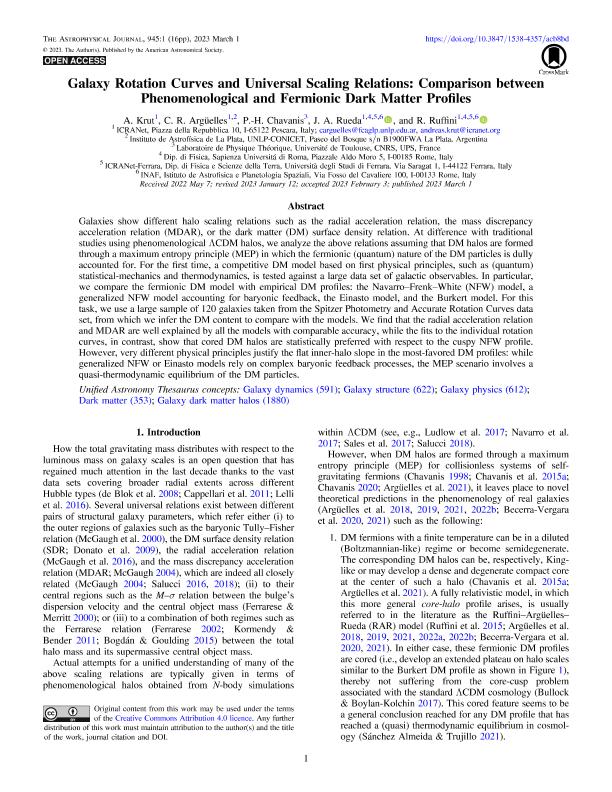Mostrar el registro sencillo del ítem
dc.contributor.author
Krut, A.
dc.contributor.author
Argüelles, Carlos Raúl

dc.contributor.author
Chavanis, P. H.
dc.contributor.author
Rueda, J. A.
dc.contributor.author
Ruffini, R.
dc.date.available
2024-04-23T11:30:50Z
dc.date.issued
2023-03
dc.identifier.citation
Krut, A.; Argüelles, Carlos Raúl; Chavanis, P. H.; Rueda, J. A.; Ruffini, R.; Galaxy Rotation Curves and Universal Scaling Relations: Comparison between Phenomenological and Fermionic Dark Matter Profiles; IOP Publishing; Astrophysical Journal; 945; 1; 3-2023; 1-16
dc.identifier.issn
0004-637X
dc.identifier.uri
http://hdl.handle.net/11336/233831
dc.description.abstract
Galaxies show different halo scaling relations such as the radial acceleration relation, the mass discrepancy acceleration relation (MDAR), or the dark matter (DM) surface density relation. At difference with traditional studies using phenomenological ΛCDM halos, we analyze the above relations assuming that DM halos are formed through a maximum entropy principle (MEP) in which the fermionic (quantum) nature of the DM particles is dully accounted for. For the first time, a competitive DM model based on first physical principles, such as (quantum) statistical-mechanics and thermodynamics, is tested against a large data set of galactic observables. In particular, we compare the fermionic DM model with empirical DM profiles: the Navarro-Frenk-White (NFW) model, a generalized NFW model accounting for baryonic feedback, the Einasto model, and the Burkert model. For this task, we use a large sample of 120 galaxies taken from the Spitzer Photometry and Accurate Rotation Curves data set, from which we infer the DM content to compare with the models. We find that the radial acceleration relation and MDAR are well explained by all the models with comparable accuracy, while the fits to the individual rotation curves, in contrast, show that cored DM halos are statistically preferred with respect to the cuspy NFW profile. However, very different physical principles justify the flat inner-halo slope in the most-favored DM profiles: while generalized NFW or Einasto models rely on complex baryonic feedback processes, the MEP scenario involves a quasi-thermodynamic equilibrium of the DM particles.
dc.format
application/pdf
dc.language.iso
eng
dc.publisher
IOP Publishing

dc.rights
info:eu-repo/semantics/openAccess
dc.rights.uri
https://creativecommons.org/licenses/by-nc-sa/2.5/ar/
dc.subject
GALAXY DYNAMICS
dc.subject
GALAXY STRUCTURE
dc.subject
GALAXY PHYSICS
dc.subject
DARK MATTER
dc.subject.classification
Astronomía

dc.subject.classification
Ciencias Físicas

dc.subject.classification
CIENCIAS NATURALES Y EXACTAS

dc.title
Galaxy Rotation Curves and Universal Scaling Relations: Comparison between Phenomenological and Fermionic Dark Matter Profiles
dc.type
info:eu-repo/semantics/article
dc.type
info:ar-repo/semantics/artículo
dc.type
info:eu-repo/semantics/publishedVersion
dc.date.updated
2024-04-22T11:51:24Z
dc.journal.volume
945
dc.journal.number
1
dc.journal.pagination
1-16
dc.journal.pais
Reino Unido

dc.description.fil
Fil: Krut, A.. No especifíca;
dc.description.fil
Fil: Argüelles, Carlos Raúl. Consejo Nacional de Investigaciones Científicas y Técnicas. Centro Científico Tecnológico Conicet - La Plata. Instituto de Astrofísica La Plata. Universidad Nacional de La Plata. Facultad de Ciencias Astronómicas y Geofísicas. Instituto de Astrofísica La Plata; Argentina
dc.description.fil
Fil: Chavanis, P. H.. Centre National de la Recherche Scientifique; Francia
dc.description.fil
Fil: Rueda, J. A.. Università di Ferrara; Italia. Università degli studi di Roma "La Sapienza"; Italia. Istituto Nazionale di Astrofisica; Italia
dc.description.fil
Fil: Ruffini, R.. Istituto Nazionale di Astrofisica; Italia. Università di Ferrara; Italia. Università degli studi di Roma "La Sapienza"; Italia
dc.journal.title
Astrophysical Journal

dc.relation.alternativeid
info:eu-repo/semantics/altIdentifier/doi/http://dx.doi.org/10.3847/1538-4357/acb8bd
Archivos asociados
